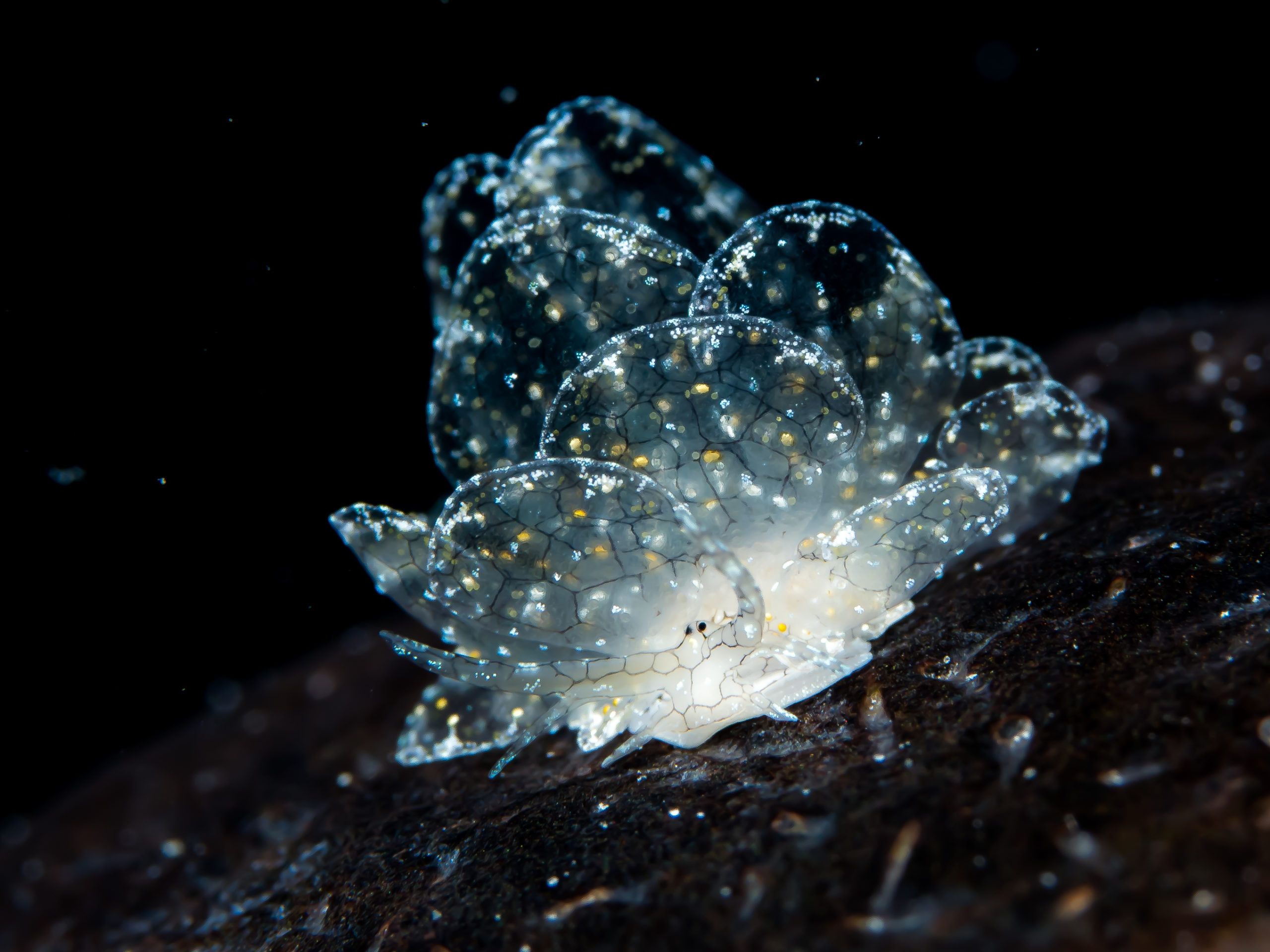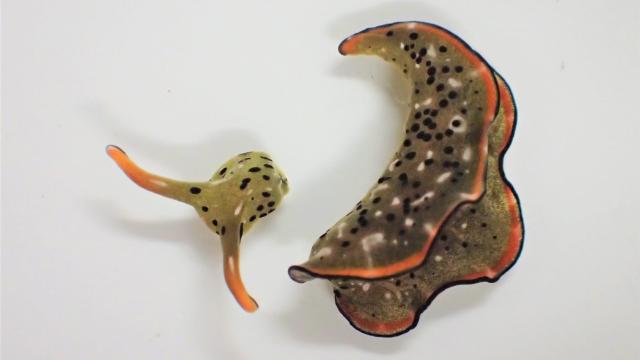Looking like opened pea pods with a lustrous sheen, the sea slugs Elysia cf. marginata and Elysia atroviridis aren’t your average gastropods. First off, they’re members of sacoglossa, a clade of slugs known for taking the algae from marine plants and integrating the chloroplasts from that algae into their own cells, allowing them to get energy from sunlight. These two slug species are also capable of extreme regeneration; they can sever their heads and grow entirely new bodies.
New research published today in Current Biology describes this incredible feat of autotomy, or self-amputation. (It’s worth mentioning that the bodies do not generate new heads.) The discovery was made in Yoichi Yusa’s lab at Nara Women’s University in Japan, which cultures sea slugs from eggs to adulthood across generations to better understand these slimy creatures.
Sayaka Mitoh, a biologist at the university and lead author of the recent paper, stumbled upon the slugs’ well-intentioned self-dismemberment when she came across an individual in the lab whose head was no longer connected to its frilled, pickle-coloured body. But its head was still moving.
“We had not thought they would perform such an unusual autotomy,” Mitoh said in an email. “This finding was completely a serendipity.”
Once the team found one self-severed individual, they went about investigating why, and precisely how, that breakage occurred. These observations included attempts to induce a self-beheading, by imitating the sort of cursory nips a marine predator would make on the slug in the wild (perhaps, they guessed, the slug parting with its body was similar to a fighter jet pilot using an ejector seat).
The researchers tied a nylon cord around where the slug’s head met its body, where it seemed the slug was predisposed to make the corporeal-cranial split. They did this lightly enough, more akin to a too-tight necktie than an asphyxiating agent — but the slugs don’t have respiratory systems as vertebrates do, so no biggie either way.
Though the true nature of the autotomy remains unknown, the team was able to induce autonomy in all but one slug within a day. In the paper, Mitoh’s team suggested that autotomy in the wild could happen in Elysia atroviridis because the slug is regularly encumbered with planktonic parasites — perhaps leaving a parasite-ridden body behind to grow a new one is the easiest way of dealing with the infestation. The researchers found that the slugs could go days without their hearts (located in the body, just below the breakage plane), and, over the course of a couple weeks, the new bodies were nearly at full size. In the paper, the team posited that the slugs could get by without their bodies by surviving purely on their photosynthetic capabilities.
“While living for a few days without a heart might sound impossible from our human perspective, these animals actually breathe through their skin and completely lack gills,” said Elise Laetz, a expert in photosynthesising sea slugs at the University of Groningen in the Netherlands who isn’t affiliated with the new study. “It doesn’t surprise me that they can withstand a week without a heart to pump oxygenated hemolymph (like blood for invertebrates) around their bodies while they regenerate a new one.”
Laetz said in an email that the photosynthesis-as-rations idea seemed less likely, as a lot of the mechanisms for kleptoplasty (that unique ability of taking algal chloroplasts and using them to harness solar energy) are located in the body, not the head.
“Chloroplasts are stored in the slug’s digestive gland, which is highly branched and mainly located in the body of most sacoglossan species. When the slug autotomises its body, it throws away most of its chloroplasts and therefore most of the energy it could get from those chloroplasts,” Laetz said. “I think it more likely that the slug fuels regeneration by feeding directly after it autotomises its body, as the authors observed.”
Much more research needs to be done to better understand how these wriggly little slugs eke out existence without the help (or hindrance) of the majority of their corporeal form. The new observations suggest there are a lot more questions to ask of these animals.

“We want to study whether other species of sacoglossans have this ability, to study the evolutionary pattern and process of such extreme autotomy and regeneration,” Mitoh said. “The function of the autotomy is also worth studying. Moreover, we will further explore the mechanisms underlying this phenomenon at the tissue and cellular levels.”
They may not have the charisma of a “corgi” giraffe or the zany DNA of a platypus, but the photosynthesising, self-beheading sea slugs within sacoglossa deserve every bit the same amount of attention. The headless bodies will continue to be probed, and the bodiless heads even more so.
“Observations like those presented in this paper highlight the need for fundamental scientific research on all branches of the tree of life,” Laetz said. “You never know when an animal as innocuous as a sea slug has an ability that could lead to advancements in applied research.”
